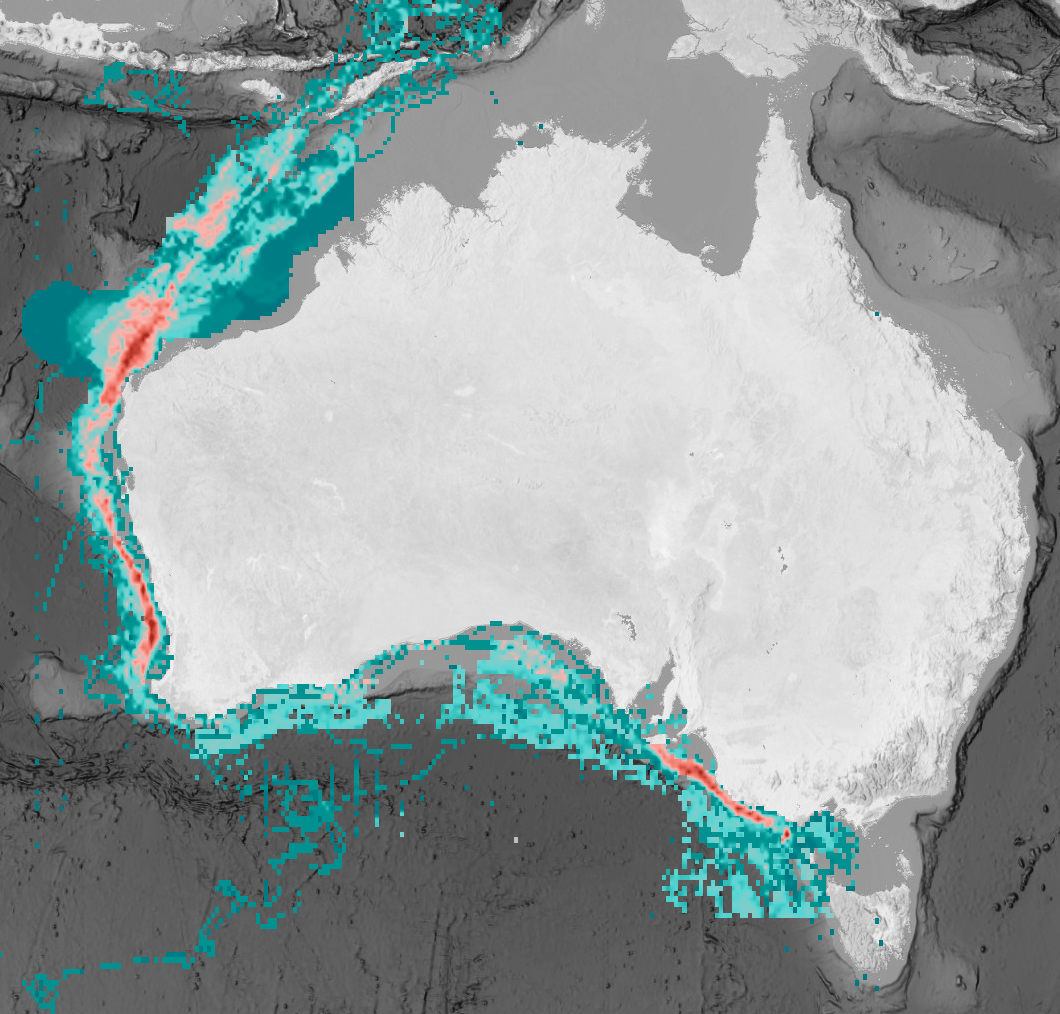pygmy blue whale
Type of resources
Topics
Keywords
Contact for the resource
Provided by
Years
-

The offshore renewable energy (ORE) sector is rapidly developing in Australian waters to meet the country’s carbon emission targets. However, new developments in the marine environment pose added risk to threatened species. The Eastern Indian Ocean pygmy blue whale (Balaenoptera musculus brevicauda) was identified as a key species by the Australian Government for understanding the potential impacts of ORE developments. This subspecies ranges from the Subtropical Convergence (~40-45°S) to Southeast Asia (~2°S) with most of its documented distribution within the Australia Exclusive Economic Zone. Pygmy blue whale distribution overlaps various anthropogenic activities across their range, which suggests that some level of exposure to pressure and threats is likely. We compiled all available spatial data to quantify the full and foraging distribution of pygmy blue whales and quantified exposure to individual and cumulative threats across the species distribution. Threat exposure analysis included expert elicitation to gather expert input on the probability of exposure to a threat occurring from the spatial overlap between pygmy blue whale distribution and anthropogenic pressures, with a focus on areas undergoing ORE development. The cumulative exposure assessment indicated a relatively low level of exposure of pygmy blue whales to existing threats within Australian waters, particularly those that occur within declared ORE areas. However, several gaps in data and knowledge were identified that need to be addressed prior to development of the ORE industry. Our results provide a robust baseline that can be directly incorporated by industry and regulators as spatial layers into impact assessments. The study helps inform Government, and proponents of wind farms on the current state of knowledge of pygmy blue whale distribution and exposure to threats in Australian waters for use in decision-making, helping facilitate the sustainable development of the ORE industry in Australia.
-

This record provides an overview of the NESP Marine and Coastal Hub Research Plan 2024 project "Assessing the vulnerability of southern right whale and blue whale populations to disturbance from windfarm developments". For specific data outputs from this project, please see child records associated with this metadata. -------------------- Australia is entering a phase of rapid offshore renewable energy development, with several marine regions earmarked for wind farms. Underwater noise generated by the construction and operation of large wind turbines may affect species such as whales that rely on their acoustic environment to feed, breed and survive. This desktop study used available data and expert elicitation to develop an interim Population Consequences of Disturbance (iPCoD) model for blue whales and southern right whales in relation to one or multiple offshore wind farm developments off Portland and Gippsland, Victoria. This method has been used internationally to assess the impacts of offshore wind farm developments, including for harbour porpoises in British waters. The model follows a decision pathway to consider factors such as: • when and where development activities overlap with populations; • the proportion of populations affected; • the life stages and reproductive phases affected; and • the chances of repeated disturbance. The model was used to predict the timing and location of cumulative impacts of the proposed activities at a regional scale, identifying which species are at ‘high-risk’ and are a priority for further research; noise levels mitigation measures required to adequately reduce the risk of compromised population viability; what research is needed to better understand population-level consequences of noise; and which mitigation measures can substantially reduce the risk of population-level effects. The iPCoD model will be able to be updated as new data become available, and is relevant for assessment against other ocean-based activities such as oil and gas infrastructure and carbon capture and storage. Outputs • iPCoD model outputs [dataset] • Species distribution maps, as derived for existing observational data [spatial visualisation/story] • Final Project Report [written]
-

This record provides an overview of the NESP Marine and Coastal Hub Research Plan 2024 project "Potential impacts of offshore wind developments on eastern Indian Ocean pygmy blue whales (Balaenoptera musculus brevicauda)". For specific data outputs from this project, please see child records associated with this metadata. -------------------- Pygmy blue whales (Balaenoptera musculus brevicauda) are listed as Endangered under the Environment Protection and Biodiversity Conservation Act (EPBC 1999), and their distribution and Biologically Important Areas (BIAs) overlap with areas proposed for offshore renewable energy (ORE) development in Western Australia, South Australia, Victoria, and potentially NSW. This project will quantify the distribution and location of areas of residency (e.g., foraging) for eastern Indian Ocean pygmy blue whales, where these overlap with proposed ORE developments, and assess the potential impacts of these developments to the species in addition to existing impacts from other anthropogenic activities. The outputs from this project will assist government, regulators, proponents, and other stakeholders in the assessment and mitigation of ORE projects to this threatened species, and will identify future research and associated data collection needs. Outputs • Spatial layers quantifying the relative distribution including migratory corridors and foraging areas across the known eastern Indian Ocean pygmy blue whale range [dataset] • Spatial layers of habitat suitability distribution [dataset] • Spatial layers for human activities identified as key pressures in this study [dataset] • Spatial layers of cumulative impact score across the species' range including potential threats from ORE and existing threats from other industries [dataset] • Final project report [written]
 IMAS Metadata Catalogue
IMAS Metadata Catalogue